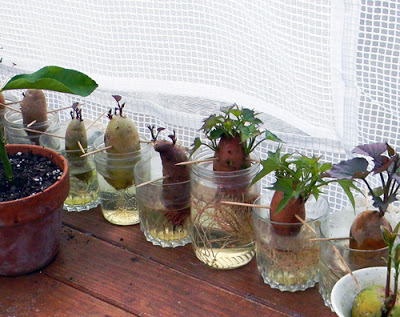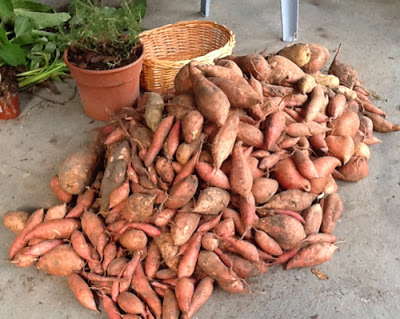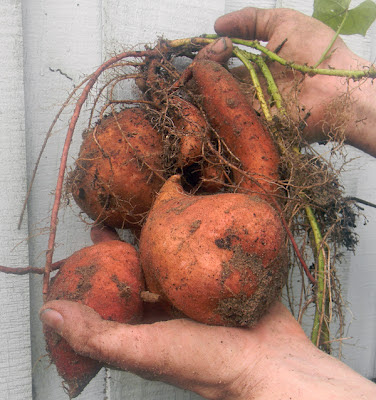 What makes the sweet potato easy to grow is its incredible vitality and resilience. Those vines ramble and root like nobody’s business!
What makes the sweet potato easy to grow is its incredible vitality and resilience. Those vines ramble and root like nobody’s business!
Sweet potatoes are just about my top survival crop.
It is widely grown as an annual across the south – yet it’s a perennial in Florida and the tropics.
A relative of the morning glory, the sweet potato is highly nutritious, calorie-filled, packs less of a glycemic hit than grains, cassava or potatoes and stores excellently. However, it doesn’t like frost, so you’re not going to get any growth during the winter. And don’t plant them too early the first year – it’s better to wait until there’s absolutely no chance of freezing your tender young starts.
Speaking of “tender young starts,” anyone ever stuck a few toothpicks into a sweet potato from the store, stuck it in a glass, then watched the buds turn into vines? If not, grab a potato and try it. The new vines that form can be broken off and planted in the ground once they get to be a few inches long. The potato will continue producing new ones for months. These little vines are called “slips.”
You can also bury sweet potatoes on their sides in a pot or flat of soil and use the vines as they emerge.
Make sure to keep them watered as they get established. Once they’re established, they’ll grow like weeds.
I know people will tell you all kinds of things about harvest times, etc., but I usually pull sweet potatoes in November… or when I get tired of their vines covering everything. I follow the vines and pull up all I can. Invariably I’ve left some in the ground that return the next year, and that’s fine. Get them before frost, if you can help it.
One thing to remember is that sweet potatoes are pretty bland until you let them sit and age for a while. When you dig the potatoes, let them sit out for a little while to dry, then put them in a basket, dirty or not. After a few weeks’ storage they’ll sweeten up. They keep for a long time under cool dry conditions, too.
Months and months.
I’ve stored sweet potatoes for six months and still had decent roots to eat, despite what you read about short storage times.
Another benefit to the sweet potato: its leaves are edible raw or cooked. We eat sweet potato leaves in our salads all summer and fall. They don’t have a lot of flavor, but they’re a great salad stuffer and have a pleasant crunchy texture, provided you don’t pick when they’ve been wilted by the sun.
This plant is excellent all around – just don’t eat the roots raw. They won’t kill you, but they do have some anti-nutrients that are removed during cooking. FYI.
 The picture at the top of the little sweet potatoes in water was taken in my greenhouse this spring.
The picture at the top of the little sweet potatoes in water was taken in my greenhouse this spring.
I bought an organic “sweet potato assortment” in shrink-wrap at Publix.
It was a total gimmicky thing with a few small different-colored roots in a row, selling for the ridiculous price of $2 and change, ready-to-microwave! I thought “heck with that – I can grab about 5 cultivars of sweet potato in one fell swoop and PLANT THEM!”
So I did, and had some very interesting varieties growing in the garden this year. The picture to the above right was most of this year’s harvest.
God is good! (And sweet potatoes aren’t half bad either.)
February 2017 Update:
Check out my video on digging and planting a bed of sweet potatoes:
That’s how easy it is!
SPUDOMETER RATING:
5 Spuds!
Name: Sweet potato
Latin Name: Ipomoea batatas
Type: Vining perennial
Size: Vines easily crawl 15-25′
Nitrogen Fixer: No
Medicinal: No
Cold-hardy: No
Exposure: Full sun/part shade. Lots of sun is the best.
Part Used: Roots, leaves
Propagation: Slips, cuttings, roots
Taste: Excellent
Method of preparation: Roots cooked, leaves raw or cooked
Storability: Excellent
Ease of growing: Easy
Nutrition: Excellent
Recognizability: High
Availability: High




20 comments
Are sweet potatoes perennial as far north as Ocala? And do you have any info on their resistance to root knot nematodes?
I just found this blog and am thoroughly enjoying reading about these crops from a Florida perspective. What zone are you in?
Thanks for stopping in.
Yes – they're a perennial here, though they die back a lot in the winter. I've got them planted here and there through my front yard and they've been coming back for a couple of years. Unfortunately, this far north they're not nearly as impressive as they are further south. It's a better annual crop here than perennial, in my experience. Though – that said – I had it occasionally come back from the roots in the spring when I lived in TN. My deep mulch beds probably helped.
According to the new USDA zone map (which is a joke), we're solidly in zone 9. In reality, this is zone 8 some years, zone 9 in others. It used to be zone 8b/9a, which makes more sense. Unlike areas closer to the coast, we don't get much protection from extreme swings. Sometimes it will hit 12 degrees or so overnight, though never for more than an hour or so.
Thanks for the info. I think I am going to plant a large patch, harvest a few bushels for the family, and then turn the pigs lose. Your blog got me to doing some additional reading and it turns out sweet potatoes make an excellent forage; some even bale sweet potato hay. It had never occurred to me that the plants would be both tasty and nutritious.
That's a whole lotta good in a plant to cheap and easy to grow.
What can be done about sweet potato weevils? They are real problem in my garden. I don't want any pesticide spray, so I need some natural solutions if there are any.
I love this site! You have given me soo much information! and I thought I was a seasoned gardner LOL fascinating about the Spanish nettle, I have noticed all the bees especially when other flowers in my yard are not blooming such as in winter and I have left some also for the bees, I still dont like the weed, but incredible that it is edible!!!!!!!!!!!! now I will give us some respect LOL
I am trying to raise as much of my own food in my small yard in St pete, it is amazing how much we can grow here. I will try again on the pineapples, and definately will do the sweet potatoes.
I have a few other trees in my yard, a small peach, olive, Barbados cherry, and a peanut butter tree, and dwarf mulberry. I also plant crowder peas, and oh my goshhh they live in the hottest part of summer and produce a dried bean right on the vine.
I would love to get in contact with you and possibly share some plants.
sue ellen in st pete
Just signed up to follow your blog. When is a good time to plant my sweet potatoes. I live in the New Port Richey area and will be using a Smart Pot.
Shelly
Planted sweet potatoes here in Central Florida for the first time last year. My first harvested sweet potato looked like and as big as a fetus! Some sweet potatoes looked like string beans. My horse loved them as treats. Prepping the garden this year, I found more little sweet potatoes from last year and replanted them in a new patch. They really are perennials here in Central Florida.
—Jeanne
The variety I use is Centennial, and it produces some of the sweetest ones you'll ever have. One caution though – don't plant them in very loose soil. I tried them in a new raised bed garden that was basically very loose potting soil (you could easily punch your fist down into the soil half way to your elbow). Rather than nice round sweet potatoes, it just formed long thick roots, with the biggest size a bit thicker than your thumb. The taste was there, of course, but you couldn't really cook and eat them. They need some resistance as they form the roots. I transplanted them into a patch of ground that I had covered with a truck load of mushroom compost. It was pretty heavy soil, and it formed perfect sized sweet potatoes.
In West Africa, sweet potatoes are also grown as a green, and not just the roots. My understanding is that they actually produce more sweet potato roots when some of the top is harvested and eaten as a salad. I'd like to see a careful study on that to be sure, but I learned that from missionaries stationed in Sierra Leone.
Being only years in Florida, storage of food has been diffucult…potatoes, onions, squash and now I have sweet potatoes growing. Any tips for storing these guys??
I’ll answer this question in a fell-length post in a few days – it’s a very good topic to cover.
Are root-knot nematodes an issue for growing sweet potatoes? Would love to plant them here in Miami!
I’ve had them suffer some damage from root-knot nematodes. I grow mustard greens as a cover crop in the off season, plus add lots of compost to keep the nematodes down.
Can sweet potatoes be harvested anytime or do you have to wait? I was wondering if I could just pull a plant each month and let them cure till sweet then eat them … AND… If I let my leeks, garlic and onions go to seed will new onions grow next year that fall to the ground? I want a few areas of onions and leeks and garlic to come up each spring like in the wild. How about any other plants? Radish, Beets, Carrots? Will any of them come up year after year if left to seed on the ground?
My favorite of all potatoes, even for potato salad. Some garam masala, and other Indian/Asian spices and they’re so good. Great for breakfast!
Oh yeah. And they don’t push your blood sugar all around like white potatoes.
[…] via thesurvivalgardener.com […]
Absolutely love your site!! Im constantly researching to learn proper plant names , how to use them and ways to grow them in zone 9b!! Your site by far has the most accurate info I’ve found and I enjoy all the funnies that you add in. Keep up the good gardening!! Thank you for your time in making this site to help all of us gardeners be happier and healthier!
Thank you, Kc. Glad to have you here.
I love learning how to plants.. It’s a great deal for me for i am not such a person with green thumbs.. i learned a lot from this site! …thank you so much for sharing your wonderful and fruitful ideas… I love it…
David, I am a fan of your YouTube videos!
I got started very late trying to grow sweet potatoes from what I thought was a really good one to start slips. Buy the time I finally got them planted, I only had about 5 good weeks of growth. I had intended to harvest some vigorous slips, but missed my opportunity when I forgot to run out prior to a record cold night that killed my vines.
I dug up one of my plants (the best) to see if I possibly had any small potatoes I could overwinter, but it has just one little one started that I fear is too small (the size of a fingertip). However, I have good roots that are up to 2 feet long in a clump.
I live in Missouri and want to have a normal start to growing these next spring. I wish I could include two pictures. I really am not sure about the best way to store. While I am leaving some of the other smaller plant root systems in the ground, I don’t know that they will survive a (southern) Missouri winter. Tips? Ideas? I don’t know that I have a decent storage place anywhere to keep the root clump between 50 and 60 degrees.
Comments are closed.